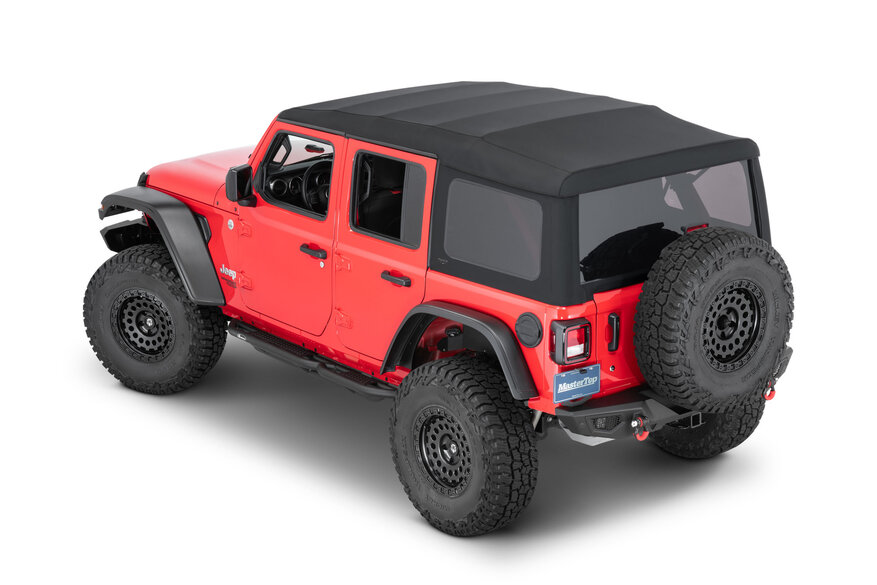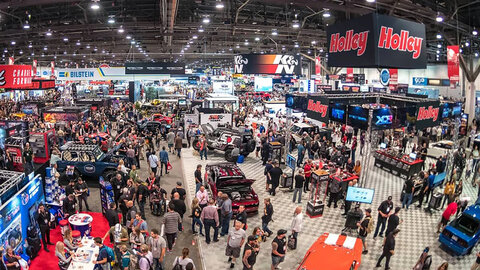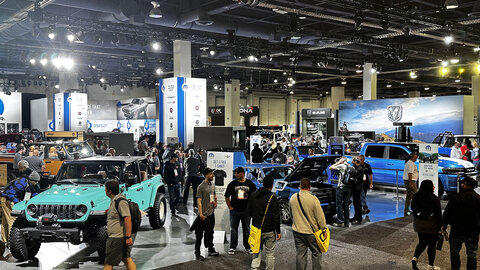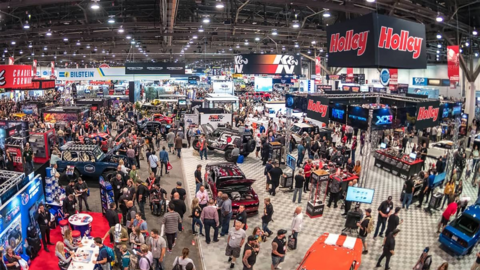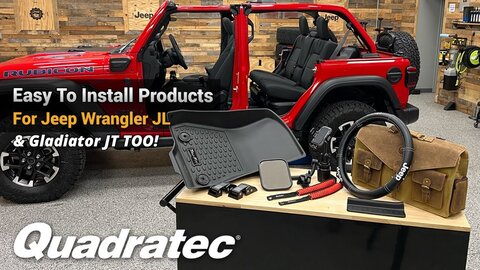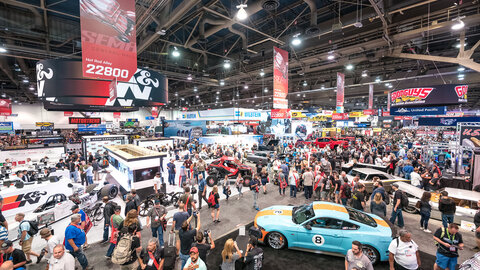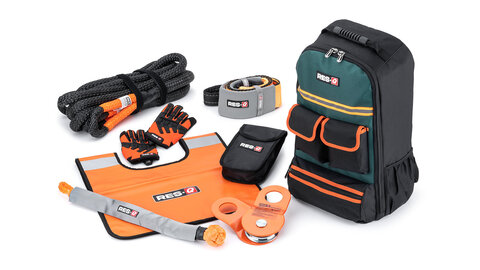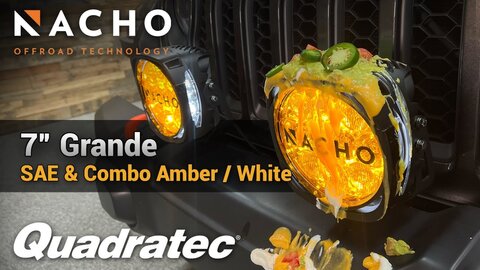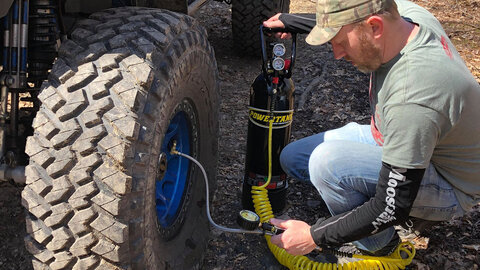by Matt Konkle
Managing Editor
It may not be an argument in the same vein as square headlights versus round ones, but it is something Jeep owners have discussed for decades.
On one side is quiet security that does involve a little open air when desired. On the other is zip-out, fold-down freedom that may not be as quiet, but offers a full open cab when the weather cooperates. And sometimes when it doesn't.
Jeep soft and hardtop differences and which one is better.
A top is one of the first decisions made when considering a Jeep, and one many also wrestle with when their current version can no longer handle the load.
For some, it may just be about the quiet perfection of a hardtop — not having to worry about rattling metal hardware, or whether those side window zippers will slide back into place each time they are undone. For others, well, the simplicity of unlatching a soft top and maneuvering its material back and out of the way on warm, perfect days just trumps having to deal with a bulky hardtop.
So when you are looking to decide which top will be the best on your Jeep Wrangler — whether you are buying the vehicle new or replacing a current top, it may not be best to make that decision based strictly on the opinions of friends who have one or the other. A top should be a personal choice, and something that fits what you want out of owning a Jeep. There are advantages and disadvantages to each one, and those distinctions can be essential to choosing the right match for you.
Hardtop Advantages
Quiet and strong, a Jeep Wrangler hardtop does enjoy several advantages that a soft top simply cannot provide — with durability and security right at the top of that list. Here is what you can expect from a hardtop:
All Jeep Wrangler hardtops are constructed with solid fiberglass so they are clearly the more durable option. They are extremely solid and can withstand significant impacts, especially on the trail, that would normally tear through a soft top. This durability extends the life of that top pretty much for the vehicle’s lifespan, and also means you will not have to deal with as much maintenance as those with a soft top.
While Jeep Wrangler heaters are significantly powerful, even the best soft top can leak heat during colder months. A hardtop provides more insulation, so you can keep that colder air out of the cabin. Conversely, summer heat is less penetrative when you have a hardtop so that air conditioned cabin stays cool. Plus, the hardtop’s insulation also allows for a much quieter interior as you drive — no rattling metal hardware to destroy your conversation or musical enjoyment.
For those looking for extra space, a hardtop is pretty much mandatory for any roof rack system. Outdoor sporting equipment such as kayaks or other bulky items simply can't fit inside your vehicle, so a rack is a great way to carry them to your destination. Additionally, those who overland will find a rack to be a great help for things like tents and other campsite necessities.
Finally, it doesn’t happen often, but soft tops can be a security risk should you have valuable items inside the Jeep. That’s why many opt for a hardtop because that thick fiberglass simply cannot be cut with a knife, nor can its windows be slashed or unzipped. Nothing is foolproof, but the added security means more protection for any valuables and items you store inside your Wrangler.
Disadvantages of a Hardtop
While hardtops certainly have a lot to offer, there are some disadvantages you should know before finalizing any decision. Here are some of the most important:
A Jeep Wrangler hardtop is not the easiest thing to work with when you want to take it off the vehicle. So on those nice, warm weather days, or when you simply decide to change the top for any reason, you’ll need some help. Typically, removing that top is a two-person job and does require the removal of hardware supporting the top. That timely process needs consideration, especially if you are trying to put the top back on to beat inclement weather.
When you accidentally rip a soft top window or destroy a zipper, there is a cost involved to replace, but it isn’t nearly as much as a damaged hardtop window or broken fiberglass. A Jeep Wrangler hardtop normally is much more durable than a soft top, however it can be quite costly when it is eventually time to replace it, or to fix a broken part. So the price factor is certainly something to keep in mind if you plan to drive your Wrangler for a long time.
Not many people fully take off their soft top when it is nice outside — most just recline it back. But hardtop owners need to totally remove the thing if they way to enjoy an open cabin. That means you’ll need a place to store your hardtop so it does not get damaged. There are plenty of options available like storage carts and hoists, but these do require space so you’ll need to make sure you have somewhere to fit the hardtop when it is off the vehicle.
Advantages of a Soft Top
Once upon a time, a soft top was simply the only top you could get on a Jeep. And these days it still is extremely popular because of its ease of use, affordability and versatility. If you are seriously debating on a soft top for your Jeep Wrangler, then here are several advantages that sets a soft top apart from its competition.
A Jeep Wrangler soft top is simply easy to use. When you want an open cabin, then you just unlatch the front, remove three windows and recline the top back. Within a few minutes, you can have an entirely open cabin without needing any friends to help. Then, should the weather turn bad, or you just want the sun off you, simply pull the top back up and re-attach the windows. You’ll never have to worry about the weather again. Well, that is, unless you leave the top off overnight and it rains.
Additionally, a Jeep Wrangler soft top can be folded and stored easily in small spaces should you decide to totally remove the top. In comparison, hardtops can take up a lot of space in your garage, and normally require other products in order to keep it safe. Finding room to store a soft top really does not take much effort as these can fold up pretty compact. For added protection, you can choose soft top storage bags.
Another key factor for a Jeep Wrangler soft top is its convenience. You’ll normally always have it with you when needed. This is especially true when off-roading or if you are far from home and the weather, like we said before, turns bad. With a soft top, you can easily put it back up for protection — quickly keeping you and the vehicle's interior nice and dry. If you’ve removed and stored a hard top at home, and are caught out in the rain, well, hopefully there is cover somewhere until the storm passes.
A soft top choice can also come down to affordability, and many of these tops are quite a bit cheaper than purchasing a hard top. Also, replacing a hardware part or windows, should they become damaged, is also normally less expensive than hard top repairs. Should you need to replace the entire top, you can still just buy the material to fit over the existing hardware instead of having to purchase a full replacement. So if budget is your primary concern, the soft top can be a clear choice.
Disadvantages of a Soft Top
While a Jeep Wrangler soft top can be a great addition for anyone, there are some features that do not exactly mesh with some needs. So the following disadvantages could possibly influence your final decision when considering a new top for your Wrangler.
A Jeep soft top, like the name implies, is soft and can be easily damaged by many external factors, as well as simply pulling it up or down. When on a trail, tree branches can impact the top and either scratch it badly or tear through the material. They can also puncture the plastic side or rear windows if not careful. Additionally, removing windows can cause problems over time with the zippers not catching correctly or accidentally breaking teeth on the track. Plus, a soft top average lifespan usually is somewhere between 3-5 years before it needs replacement.
Like we said before, even the best Jeep Wrangler soft top can have trouble retaining heat in the winter. But other issues during colder months can lead to plastic side and rear window problems such as scratching or clouding. Or, for those who forget, breakage if trying to remove ice with a scraper. Excessive snow on the top can even weigh it down and lead to material or hardware breakage.
Unlike hardtops, a Jeep Wrangler soft top can be excessively loud while driving — both from wind noise and hardware rattling. Some of the thicker, newer tops are somewhat quieter, but still are not as insulated as a hardtop. So those who daily drive may not like the constant cabin noise, which can get irritating over time.
Along the same lines, that thinner soft top material is very pliable and can easily be cut should a thief see something valuable inside your Wrangler. They could also zip out a side window to gain access as well, while a hardtop could have been enough to deter any incursion. Sure, this issue can be somewhat fixed by never leaving anything of value inside the Wrangler, but mistakes do happen, and a hardtop will always be more secure.
Related Articles:
What Are The Differences In Off-Roading A Wrangler TJ, JK and JL












